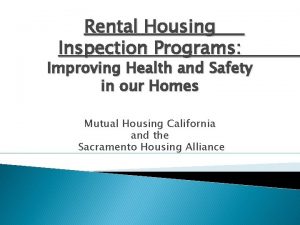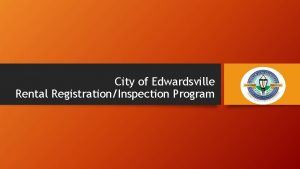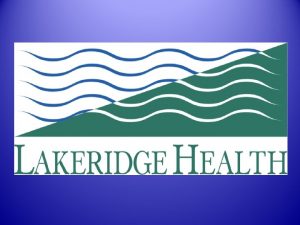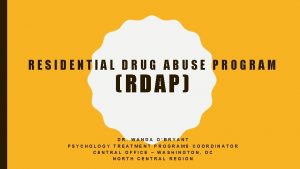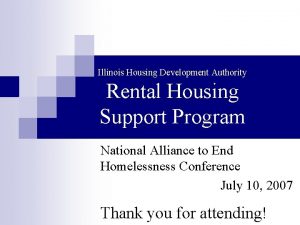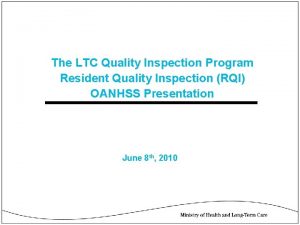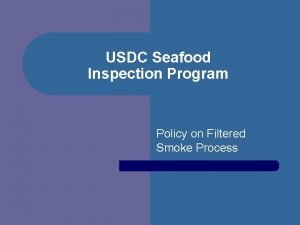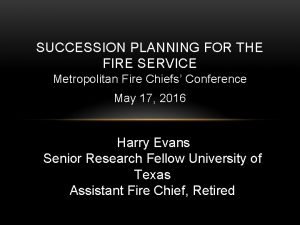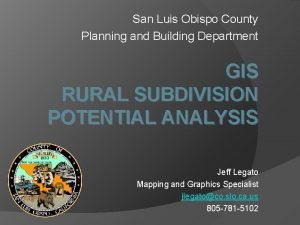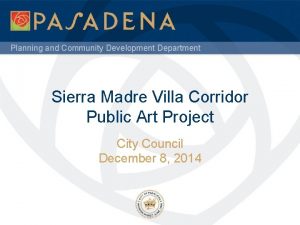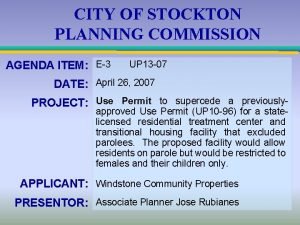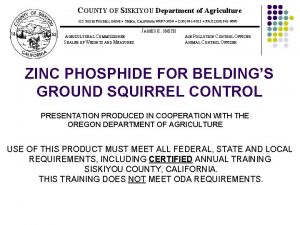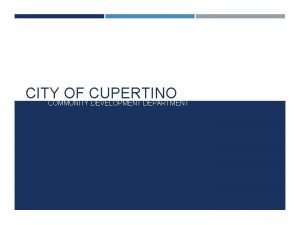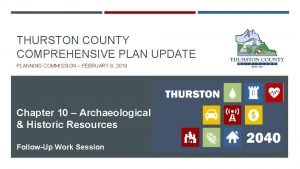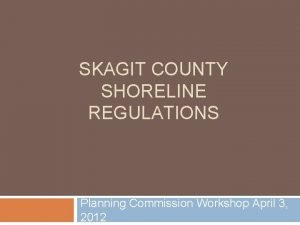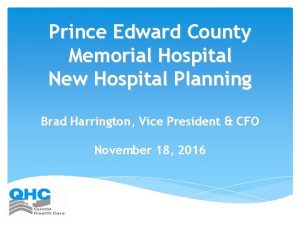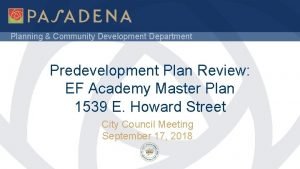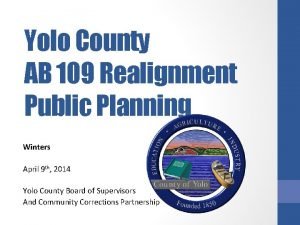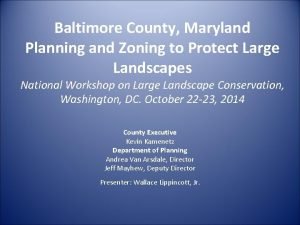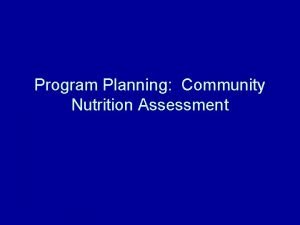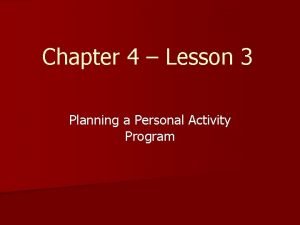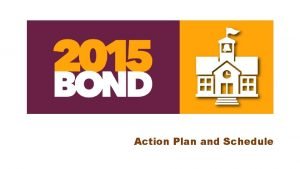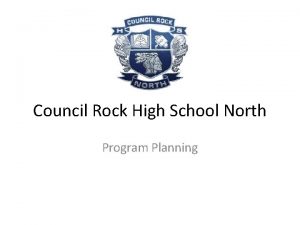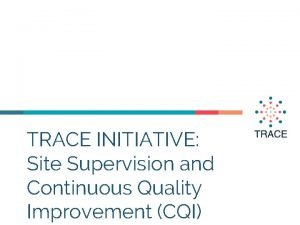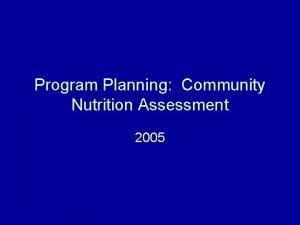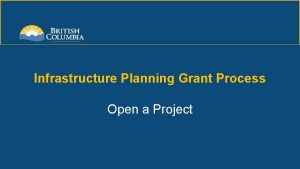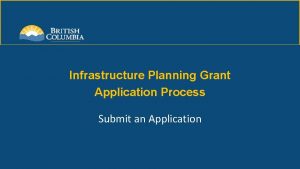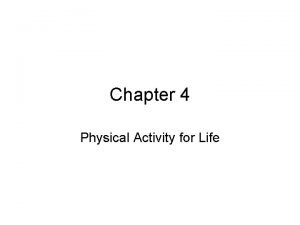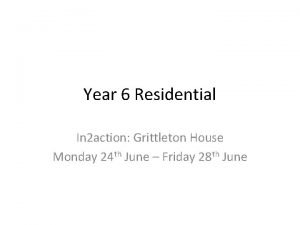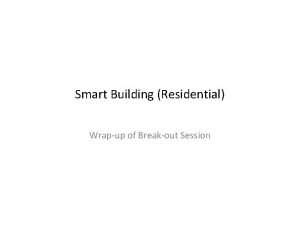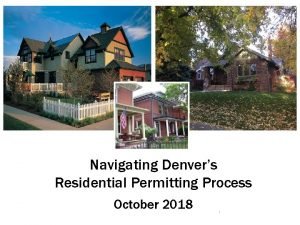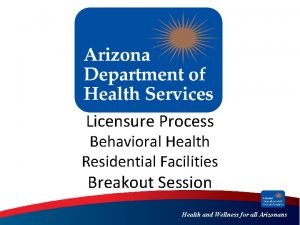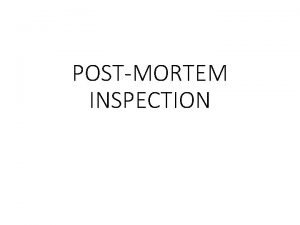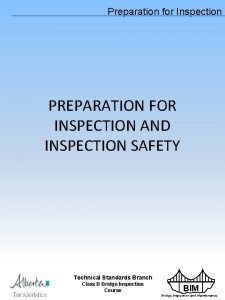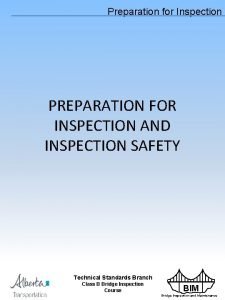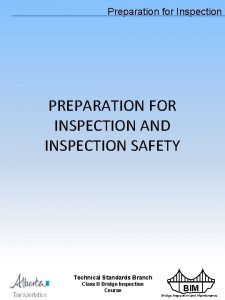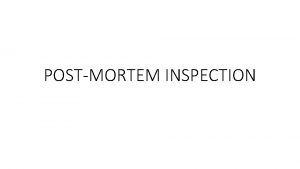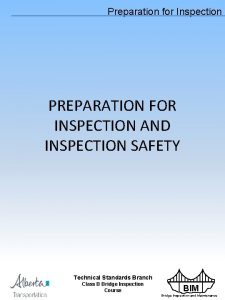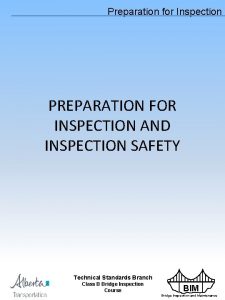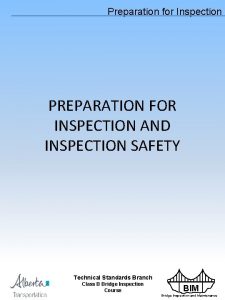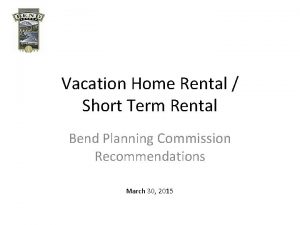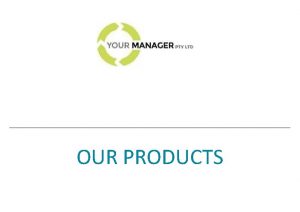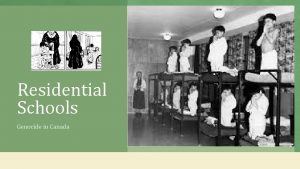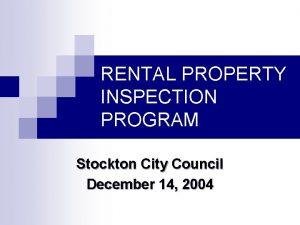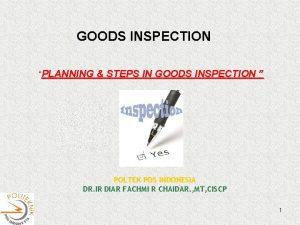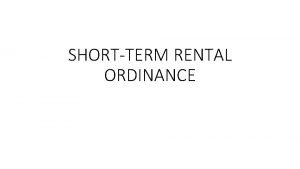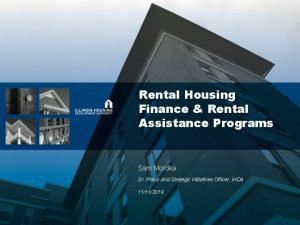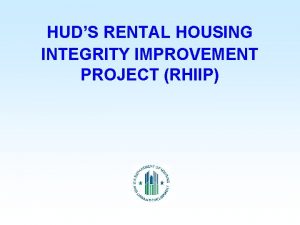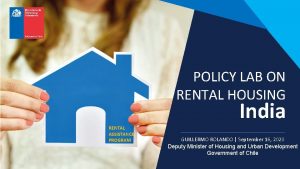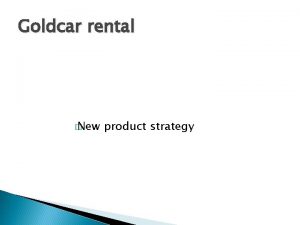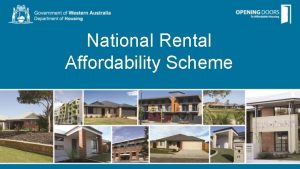Planning Department Residential Rental Inspection Program Residential Rental
























































- Slides: 56

Planning Department Residential Rental Inspection Program

Residential Rental Inspection Program - Introduction n n Project Summary Ordinance Types of Inspections n Exempt n Self Certification n City Inspection Results Annual Inspection n n Education Website information Forms and Documents Contact information

What is the Residential Rental Inspection Program? It’s a systematic inspection program of all residential rental properties to promote public health and safety by ensuring safe living conditions that may affect: n Occupant’s safety n Structural integrity of the building n The surrounding neighborhood

Process What will be sent to the Property Owner: n n Packet containing three (3) documents and a pre-printed return envelope. The first document contains one of two types of letters informing you of your registration options: 1. Registering for either a City inspection or self-certification of their rental property, or; 2. Registering for only City inspection of their rental property. n The second document is the registration form n The third document is an exemption form

Process What you will send back: (via mail or fax - received within 60 days ) n Completed Registration Form or n Exemption Form (if applicable)

Process Exemptions n New Construction n Legal Accessory Dwelling Unit n Owner Occupied n Mobile Home parks n Government Agency Inspected n Hotels / Motels – Less than 30 day occupancy (5 yrs)

Process Self Certification n n The City will send an invoice for all fees and a self certification checklist to the property owner Property owner is to complete a checklist for each unit and return to City with all payment The rental inspector will verify the checklist(s) for completion If passed, your property will be registered in our system for self certification City Inspection n n The City will send an invoice to the property owner and all fees must be paid to the City Inspection will be scheduled by the City and you will either receive a pass or correction notice If you pass inspection - rental housing certificate will be issued to the property owner. If corrections are required - re-inspection will be scheduled.

Types of Inspections Self-Certification n One checklist will be sent to the property owner, and owner to make copies n Complete a checklist for each unit and return with full payment of fees n Rental inspector to verify each checklist for completion n Every 5 years, 20% of units to be City Inspected

Types of Inspections City Inspection n A Property Owner can request a City Inspection is Mandatory if Code Enforcement case has been open or closed on a property in last 3 years Inspector will pass or issue a correction list for all items that need to be re-inspected

Inspection Process (Exterior) n n n Legible and visible address Storage of junk and rubbish/overgrown vegetation Dumpsters / trashcans Inoperable vehicles Foundation vent screens / crawl space covers Roof Stairways Electrical panels Exterior lighting Exterior walkways /exit passageways Water Heaters Infestation And for Multi-Family Dwellings n Fire extinguisher n Fire sprinkler systems n Electrical / Gas meters n Existing fire lanes clearly marked

Inspection Process (Exterior) Legible and visible address numbers or letters posted on building. n n n Address numbers and letters shall be plainly visible and legible from the street Address to be in contrasting color to the building Address numbers and alphabetical letter to be a minimum of 4” in height, if new

Inspection Process (Exterior) Storage of Junk, Rubbish and Debris and/or Overgrown Vegetation is prohibited n n Household trash, tires, trees, scrap wood, scrap metal, or anything considered rubbish, junk, or trash stored or discarded property Properties must be clear from overgrown/dry vegetation or weeds

Inspection Process (Exterior) Dumpsters/Trash Cans n n n Dumpsters and trash cans shall be free from overflowing and excessive trash as not to be an attractive nuisance. Must be in an enclosure (if provided). Trash is to be stored out of the public right-of-way (streets, sidewalks, pathways).

Inspection Process (Exterior) Inoperable/Unregistered Vehicles n n Inoperable vehicles must be stored in locations other than the front yard and exterior side yards. Vehicles must be stored or parked on paved surfaces.

Inspection Process (Exterior) Foundation Vents Screens/Crawl Space Covers n n n Foundation vents and crawl space covers need to be in place to prevent the intrusion of pests. Foundation vents shall be covered with screens Crawl space covers to be in working order

Inspection Process (Exterior) Roof n n n No visible holes or penetrations. Roof covering to be maintained and in place. No exposed skip sheathing, plywood, or roof felt/paper. Roof to be free from debris.

Inspection Process (Exterior) Stairways n n n Should be in good condition and free of anything that may cause a trip or fall hazards. Free from visible structural defects. Handrails and guardrails to be in good working condition.

Inspection Process (Exterior) Fire Sprinkler Systems (Multi-Family Only – 3 or more units) n Must be properly serviced (annually inspected) and have inspection tag located on the unit. n Stored in a visible location n Minimum of an 2 A-10 BC extinguisher

Inspection Process (Exterior) Fire Sprinkler Systems (Multi-Family Only – 3 or more units) n If provided – Property owner must present a Certificate of 5 year inspection

Inspection Process (Exterior) Exterior Lighting n n n Approved lighting fixtures will be required at building entrances and exiting doorways. All exterior hallways are to provide lighting along the path of travel. Lighting is to be in working order, no exposed wiring and approved covers in place.

Inspection Process (Interior and Exterior) Infestation n Property will need to be free of all infestations (i. e. insects, rodents, etc). All properties in which insects and rodents are found shall be promptly exterminated by an approved process that will not be injurious to human health. Proper precautions shall be taken to prevent re-infestation.

Inspection Process (Exterior) Gas Meters/Electrical Meters n Meters to be in good working condition. n All electrical meters to be labeled. n Provided adequate working clearances. n No signs of tampering. n To be in approved locations. n Properly protected from vehicle impact.

Inspection Process (Exterior) Electrical Panels n Main and sub-panels to be in good working condition and properly labeled. n Show no signs of tampering. n Protected from physical damage. n No exposed wiring.

Inspection Process (Exterior) Exterior walkways/Exit Passageways Common Areas n Must be clear at all times. n Must be maintained in a good working order and sanitary condition.

Inspection Process (Exterior) Fire Lanes n n Need to be clearly marked by paint or signage. Buildings with fire hydrants shall have the curb located in front of the hydrant marked with red paint for a distance of 15’ in both directions. - Beware of consequences

Inspection Process (Interior and Exterior) Water Heaters n Provided with seismic straps to properly support water heater. n Properly vented. n Pressure temperature Relief Valve (PTR) should terminate to the exterior of the building (6” -24” above grade) or other approved location n Provided with protection from vehicular impact. n Provided with proper combustion air and working clearances. n Water Heaters shall not be located in bedrooms.

Inspection Process (Interior) n n n n n Hot / Cold Running Water Electrical Power Heat Sewage System Entry Doors Exits Infestation Smoke Detectors Mechanical n n n n Electrical Plumbing Counter and Sink Space Windows Flooring Sub-Flooring Walls Ceiling

Inspection Process (Interior) Hot/Cold Running Water n n Units will need to be provided with running water and the ability to provide hot water. Hot water is required at the kitchen and bathrooms.

Inspection Process (Interior) Electrical Power n Units will need to be provided with electrical power.

Inspection Process (Interior) Heat n n n Units to be provided with a heat source. Capable of maintaining a room temperature of 68 degrees in all habitable rooms Portable heaters are not permitted to be the main source of heating.

Inspection Process (Interior) Sewage System n n Units are to be provided with a functioning sewage system. Units to be clear of any surfacing sewage indoors and outdoors.

Inspection Process (Interior) Entry Doors n n Doors to be in good shape and in working order. Locks on the doors must not exceed 48” in height (unless otherwise allowed). No double key locks. Doors shall be water resistance and weather tight.

Inspection Process (Interior) Exits n n n Each unit is to be provided with a main entry/exit door. No double key locks Each bedroom within a unit is to be provided with a escape/rescue window.

Inspection Process (Interior) Smoke Detectors n n n Smoke detectors must be maintained and in working order. Smoke detectors to be located in each sleeping room, hallway centrally located between sleeping rooms, and each story. Be in compliance with code in effect at time of the installation.

Inspection Process (Interior) Carbon monoxide Detectors n n Shall be maintained and in working order. Carbon monoxide detectors shall be installed in all dwellings according to H&S Code Section 17926 n n n Single Family Dwellings by July 1, 2011 Multi Family Dwellings by January 1, 2013 State Fire Marshal Website: www. osfm. fire. ca. gov

Inspection Process (Interior) Electrical n n n All electrical wiring and electrical components will need to be in good working conditioned (i. e. , no spliced wiring, exposed wires, open junction boxes, etc). GFCI serving kitchen and bathroom receptacles should be in good working condition. Sub-panels to be labeled.

Inspection Process (Interior) Mechanical n n All mechanical equipment must be properly functioning. (appliances, venting systems and HVAC if provided etc. ) Mechanical equipment will need to be provided with working clearances.

Inspection Process (Interior) Plumbing n n n Structures to be provided with proper plumbing. Each unit to be provided with the minimum fixtures: kitchen sink, toilet, bathroom sink, and tub/shower. Toilets and Sinks are to be property secured

Inspection Process (Interior) Counter and Sink Surfaces n Counter and sink surfaces are required in the kitchen

Inspection Process (Interior) Windows n All windows to be provided with adequate weather protection. n Windows to be in good condition; No broken glass or plastic covering. n If screens or window bars are present they must function without the use of a key or special knowledge.

Inspection Process (Interior) Flooring n Floors must not be defective or of a deteriorating condition that could cause a trip or fall hazard or impact the sub-flooring.

Inspection Process (Interior) Walls n n Walls must be in good condition. Free from holes, missing sections, and damage. Sub-Flooring n Must be in good condition. n Must be free from signs of buckling or sagging with structural defects.

Inspection Process (Interior) Ceiling n Must be in good condition. n Must not be collapsing, buckling, or sagging which would suggest a structural defect or roof leakage. n Habitable rooms to be provided with a minimum 7’ ceiling height.

Certification Residential Rental Housing Certificate Residential Rental Inspection Program Date of Issue: 07 -01 -01 Property Address: 809 Center St Property/Site Description: Two story, 3 bed, 2 bath Property Owner Name: Joe Santa Cruz This property/site complies with the provisions of applicable codes and ordinances so far as could be revealed by inspection.

Forms & Documents n Additional forms and documents are available at the city website or the Planning and Community Development department www. cityofsantacruz. com/Rental. Inspections

Contact Information n n Assistant Planning Director n Alex Khoury - 831 -420 -5116 Rental Housing Inspector n Michael Stoker - 831 -420 -5119 Rental Housing Inspector n Lorenzo Sanchez - 831 -420 -5133 Rental Housing Administrative Assistant n Shelley Randolph - 831 -420 -5140 Email: rrip@cityofsantacruz. com



Why was the Residential Rental Inspection Program Developed? n n The City of Santa Cruz desires to safeguard the stock of decent, safe, and sanitary rental housing through the participation of owners, tenants, the City and the community in the Rental Housing Inspection Program. This Program will identify substandard and overcrowded residential buildings and dwelling units and ensure the rehabilitation or elimination of those buildings and dwelling units that do not meet minimum building code and housing code standards, or is not safe to occupy.

Why was the Residential Rental Inspection Program Developed? n n n The Intention of this program is to “Preserve and Enhance” the quality of life for residents who live in these buildings and dwelling units. This is a major benefit for the neighborhoods which host these structures. Fact - Over half of all the residential dwelling units in the City of Santa Cruz are rental units.

Why was the Residential Rental Inspection Program Developed? It has been noted over the years, some of these residential rental buildings and dwelling units are: n Substandard n Over-crowded n Unsanitary and unsafe The physical conditions and characteristics are in violation of city, building, state, housing and sanitation codes, which render them unfit or unsafe for human occupancy and habitation. These buildings and units are detrimental to, or jeopardize the health, safety, and welfare of their occupants and of the public.

Why was the Residential Rental Inspection Program Developed? n This Program also serves to seriously compromise the integrity and residential quality of City neighborhoods through such factors as: n Deferred property maintenance n Overcrowding n Proliferation of vehicles-attributable to the multiple tenants who rent these properties n Accumulation of excess trash and debris on or about the properties With this Program, the City further intends to abate on-going nuisances and gain compliance with Zoning Code issues, relative to rental properties. This proactive Program will help improve citizen satisfaction in their housing and neighborhoods.

F. A. Q. ’s What will the inspector be looking for? n The inspector’s focus will be on identifying substandard maintenance conditions that do not meet minimum standards established by local and state laws. The inspector will also identify : Parking and trash issues. Zoning violations. Improper living arrangements such as: (a) Unpermitted dwelling units (b) the renting of spaces not intended for habitation (c) substandard, overcrowded, unsanitary and unsafe housing conditions that render a housing unit unfit or unsafe for occupancy.

F. A. Q. ’s What happens after the inspection? n n • If the inspection reveals no violations, the issuance of a rental housing inspection certification will be issued If the inspection or any subsequent inspection reveals there are violations on the property, the owner/operator will be issued a correction notice The City inspectors will return on the scheduled correction date to reinspect the property to verify compliance. If corrections have not been made, the owner/operator will be charged for the additional City time and expense in handling the violations.

F. A. Q. ’s What are the costs to the property owner? n The annual registration fee for each applicable property would be $45. n Self-Certification Program. If accepted, the annual self-certification fee would be an additional $20 per unit for 20 percent of the units at each property. n City Inspection - The annual registration fee would be an additional $20 per unit at each property. This annual fee will cover first inspection of each unit and one re-inspection if a correction notice is issued. n If further re-inspections are required the fee is $120 per unit. n Continued failure to correct any noticed violations will be dealt with through administrative civil penalties found under Title 4 of the SCMC.

For Example: n n n 1 single family rental home or condo – Yearly cost - $45 plus $20 = $65 (Monthly cost - $5. 42) 3 single family rental homes Yearly cost under Self-Certification - $135 ($45 per property x 3) plus $20 x 1 unit = $155 (Monthly cost per unit - $4. 30) Yearly cost for non-Self-Certification - $135 ($45 per property x 3) plus $20 x 3 units = $195 (Monthly cost per unit - $5. 42) Four plex – Yearly cost under Self-Certification - $45 plus $20 x 1 unit = $65 (Monthly cost per unit - $1. 35) Yearly cost for non-Self-Certification - $45 plus $20 x 4 units = $125 (Monthly cost per unit - $2. 60)
 City of sacramento rental housing inspection program
City of sacramento rental housing inspection program Rental property inspection edwardsville il
Rental property inspection edwardsville il Pinewood oshawa
Pinewood oshawa Rdap program locations
Rdap program locations Illinois rental housing support program
Illinois rental housing support program Abaqis questions
Abaqis questions Usdc seafood inspection program
Usdc seafood inspection program Tsdps telangana
Tsdps telangana Fire department succession planning
Fire department succession planning Slo planning department
Slo planning department Sierra madre planning department
Sierra madre planning department City of stockton planning commission
City of stockton planning commission Siskiyou county planning department
Siskiyou county planning department City of cupertino planning department
City of cupertino planning department Thurston county planning department
Thurston county planning department Skagit county critical areas map
Skagit county critical areas map Pefht
Pefht Pasadena planning department
Pasadena planning department Temecula gis
Temecula gis Yolo county planning department
Yolo county planning department Baltimore county planning department
Baltimore county planning department Wilmington planning department
Wilmington planning department Strategic planning vs tactical planning
Strategic planning vs tactical planning Goal achievement matrix
Goal achievement matrix Role segmentation workforce planning
Role segmentation workforce planning N planning
N planning Aggregate planning is capacity planning for:
Aggregate planning is capacity planning for: Long medium and short term planning in primary schools
Long medium and short term planning in primary schools Language planning slideshare
Language planning slideshare Aggregate capacity planning
Aggregate capacity planning Capacity aggregation example
Capacity aggregation example Community nutrition assessment
Community nutrition assessment High school financial planning program answer key
High school financial planning program answer key High school financial planning program answer key
High school financial planning program answer key The final step in planning a personal activity program is
The final step in planning a personal activity program is The generalized model
The generalized model Personal activity plan
Personal activity plan Tentative project plan
Tentative project plan Chapter 12 lesson 4 fitness safety and avoiding injuries
Chapter 12 lesson 4 fitness safety and avoiding injuries Council rock north course selection
Council rock north course selection Cqi action plan template
Cqi action plan template Community nutrition program planning
Community nutrition program planning High school financial planning program
High school financial planning program Nefe high school financial planning program answers
Nefe high school financial planning program answers Infrastructure planning grant program
Infrastructure planning grant program Application
Application Chapter 12 lesson 3 planning a personal activity program
Chapter 12 lesson 3 planning a personal activity program Bawdsey manor pgl
Bawdsey manor pgl In2action grittleton house
In2action grittleton house Smart residential buildings
Smart residential buildings Before and after residential schools
Before and after residential schools Ap building rules 2012
Ap building rules 2012 Building permit process denver
Building permit process denver Article 7 behavioral health residential facilities
Article 7 behavioral health residential facilities Objectives of landscape design
Objectives of landscape design Hollowford residential
Hollowford residential Foxhowl education centre
Foxhowl education centre
